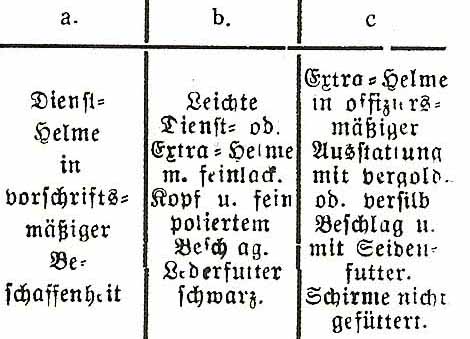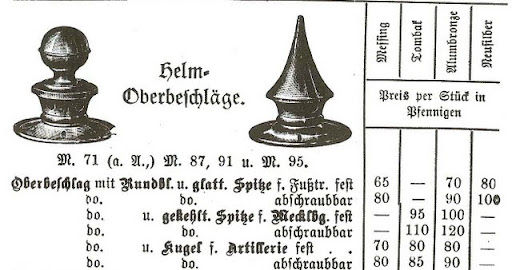argonne
Well-known member
Hello gentlemen collectors,
I drove last week to Paris for a small trip and I had the luck and was able to pick up this small oddity at a local museum in Belgium, not far from the french border. (Autumn ist harvest time..!! )
)
For me, all original anf I would describe the general condition as "good".
I particularly appreciate the clear Kammer-Stempel of the Großherzoglich Mecklenburgisches Grenadier-Regiment Nr.89 (garrison in Neu-Strelitz)
on the back visor.
I also remind Stephane_avesnes last months topic (salut la France ;-) ) about his interesting Haube showing a mixing of an IR89 II frontplate (Meckl.-Strelitz) and an IR89 I + III fluted spike (Meckl.-Schwerin). Stéphanes supposition that the quarter master of the II IR89 must have sometime had some problems because of the lack of spikes remains quite interesting and very plausible analysing this helmet too. Larcade wrote in Tome 1, page 86, that IR 89 II helmets wore a white Haarbusch ( red for musicians). Consequently, the spike of my Haube should be unscrewable but is NOT. I absolutely have no doubt that this spike always has been on this helmet. It is literally grown together with the leather body. As you can observe, the leather dome has lightly sank to the back during the past 90-100 years and the spike base gently followed this shrunkage. Absolutely no space between spike base and leather and also no shaking of the single spike units elements. No double holes in the leather behind the plate, original grommets and no "pierced" elements at the back of the wappen, as it has to be. The plate fits exactly into the holes and lets hear a gentle "click" while getting in place.
The "ghost" of the plate is as well visible although discrete.
At least a small anecdote: the whole IR 89 only fought on the western front during the war. It fought on the 5 September 1914 fast exactly at the place where I found this Pickelhaube last week! See following link (Gefecht, Feldzüge, usw):
http://wiki-de.genealogy.net/Militär/Formationsgeschichte/Deutschland/Alte_Armee/17._Division#Feldz.C3.BCge.2C_Gefechte_usw
If you are interested, the following link is showing all names of IR 89 officers killed in action 1914-1918:
http://www.denkmalprojekt.org/Verlustlisten/vl_grshrzgl_mecklenbrg_gren-reg_nr_89_wk1.htm
Enjoy these two links and following pictures!
Philippe :salute:
 [/url]
[/url]
[/img]
 [/url]
[/url]
[/img]
 [/url]
[/url]
[/img]
 [/url]
[/url]
[/img]
 [/url]
[/url]
[/img]
 [/url]
[/url]
[/img]
 [/url]
[/url]
[/img]
 [/url]
[/url]
 [/url]
[/url]
[/img]
 [/url]
[/url]
[/img]
 [/url]
[/url]
[/img]
 [/url]
[/url]
[/img]
 [/url]
[/url]
[/img]
 [/url]
[/url]
[/img]
 [/url]
[/url]
[/img]
I drove last week to Paris for a small trip and I had the luck and was able to pick up this small oddity at a local museum in Belgium, not far from the french border. (Autumn ist harvest time..!!
For me, all original anf I would describe the general condition as "good".
I particularly appreciate the clear Kammer-Stempel of the Großherzoglich Mecklenburgisches Grenadier-Regiment Nr.89 (garrison in Neu-Strelitz)
on the back visor.
I also remind Stephane_avesnes last months topic (salut la France ;-) ) about his interesting Haube showing a mixing of an IR89 II frontplate (Meckl.-Strelitz) and an IR89 I + III fluted spike (Meckl.-Schwerin). Stéphanes supposition that the quarter master of the II IR89 must have sometime had some problems because of the lack of spikes remains quite interesting and very plausible analysing this helmet too. Larcade wrote in Tome 1, page 86, that IR 89 II helmets wore a white Haarbusch ( red for musicians). Consequently, the spike of my Haube should be unscrewable but is NOT. I absolutely have no doubt that this spike always has been on this helmet. It is literally grown together with the leather body. As you can observe, the leather dome has lightly sank to the back during the past 90-100 years and the spike base gently followed this shrunkage. Absolutely no space between spike base and leather and also no shaking of the single spike units elements. No double holes in the leather behind the plate, original grommets and no "pierced" elements at the back of the wappen, as it has to be. The plate fits exactly into the holes and lets hear a gentle "click" while getting in place.
The "ghost" of the plate is as well visible although discrete.
At least a small anecdote: the whole IR 89 only fought on the western front during the war. It fought on the 5 September 1914 fast exactly at the place where I found this Pickelhaube last week! See following link (Gefecht, Feldzüge, usw):
http://wiki-de.genealogy.net/Militär/Formationsgeschichte/Deutschland/Alte_Armee/17._Division#Feldz.C3.BCge.2C_Gefechte_usw
If you are interested, the following link is showing all names of IR 89 officers killed in action 1914-1918:
http://www.denkmalprojekt.org/Verlustlisten/vl_grshrzgl_mecklenbrg_gren-reg_nr_89_wk1.htm
Enjoy these two links and following pictures!
Philippe :salute:

[/img]

[/img]

[/img]

[/img]

[/img]

[/img]

[/img]


[/img]

[/img]

[/img]

[/img]

[/img]

[/img]

[/img]



